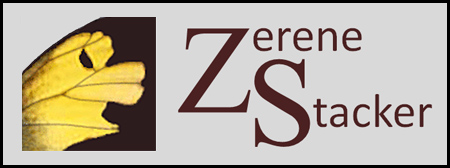Zerene Stacker Tutorials
Welcome to Documentation Central! We hope this material is helpful to anybody learning to use Zerene Stacker.
New users are particularly encouraged to read and watch the first few bullet items, from “How To Use Zerene Stacker” down through “Keyboard and Mouse Shortcuts”.
The FAQs page (Frequently Asked Questions) may also be helpful, especially if you have any difficulties.
Tutorials designed to be read:
- How To Use Zerene Stacker — a quick-start recipe and a broad overview of Zerene Stacker's capabilities, plus links to other more detailed documentation.
- Getting Started with Focus Stacking, using a compact manual focus camera.
- Using a Macro Lens on a DSLR, covering typical use with an interchangeable lens camera.
- How To Use DMap, covering how to adjust the slider and other controls for this method.
Tutorials designed to be watched: (presented as video, with written transcripts also available for translation as desired)
- Introduction to Retouching. Basic techniques, combining the best parts of multiple images of the fruit fly face. This tutorial is a quick way to learn efficient methods of navigating in a deep stack and retouching to combine the best parts of PMax, DMap, and individual source images.
- Advanced Retouching. How to get the best results from a more challenging stack of floral photography: close-up honeysuckle blossoms, shot in the wild and moving in a slight breeze. This tutorial addresses more advanced techniques such as how to play through the stack like a filmstrip, and how to adjust DMap parameters to simplify retouching.
More tutorials, designed to be read:
- Tips For Retouching. Summary of a few techniques that can make retouching go a lot faster.
- Keyboard and mouse shortcuts A reference table.
- Is it better to use a focus rail or the ring on my lens? A discussion of the options and tradeoffs between various methods of stepping focus.
- StackShot Controller Interface. StackShot is an automated macro focusing rail that makes it quick and easy to capture stacks for small subjects. This tutorial explains how to control the StackShot from within Zerene Stacker, using a graphical interface rather than the StackShot controller's own physical buttons.
- Focus Stacking Landscape Scenes discusses how to handle big scenes that just beg to be sharp everywhere, but have too much depth to make that possible in a single shot.
- Using Stack Selected to Retouch Transparent Foreground. “Transparent foreground” is a common artifact that occurs because wide aperture lenses will “look around” opaque parts of your subject to see sharp details in the background behind them. This tutorial shows how to fix the problem quickly and easily by using retouching in combination with Stack Selected.
- Using ControlMyNikon To Step Focus. ControlMyNikon is a inexpensive piece of 3rd party software that can automatically control your Nikon camera from a Windows computer to shoot a focus stack. This tutorial is a quick-start guide for new users of ControlMyNikon v2.9.
- Using Magic Lantern To Step Focus. Magic Lantern is a free and open source firmware add-on that extends the functionality of many Canon DSLRs to provide automatic acquisition of focus stacks by controlling the motor inside automatic-focus lenses. Magic Lantern has many other features and can be difficult to learn, so we're providing here a quick recipe for how to use just the focus stacking feature.
- Using Canon EOS Utility To Step Focus. Canon EOS Utility is camera support software that comes bundled with every Canon DSLR. One thing it can do is to control auto-focus lenses so that you can shoot a focus stack very precisely through a graphical user interface on your computer. The function is simple to use but not obvious. This tutorial is intended to be a recipe and quick-start guide.
- Using Nikon Camera Control Pro 2 To Step Focus. Nikon Camera Control Pro 2 is camera support software sold by Nikon. One thing it can do is to control auto-focus lenses so that you can shoot a focus stack very precisely through a graphical user interface on your computer. The function is simple to use but not obvious. This tutorial is intended to be a recipe and quick-start guide.
Recommended Presentation Slide Set
- “Introduction to Focus Stacking”, presented as a 1 hour course online for the Puget Sound Camera Clubs on 1/30/2023, can be viewed as PDF at https://zerenesystems.com/presentations/PSCC_EducationNight_20230130/IntroductionToFocusStacking_PSCC_EducationNight_20230130.pdf (64 MB download).
Other Slide Sets
- “Introduction to Focus Stacking”, presented as a 1 hour course at the Northwest Council of Camera Clubs on 11/10/2018, can be viewed as PDF at http://zerenesystems.com/presentations/NWCCC_Everett_20181110/IntroductionToFocusStacking_NWCCC_Everett_20181110.pdf (57 MB download).
- “The Art of Successful Focus Stacking”, presented at ICE 2016 (the International Congress of Entomology) on 9/29/2016, can be viewed as PDF at http://zerenesystems.com/presentations/ICE_2016_Orlando/ICE2016Presentation_T201609280800.pdf (15 MB download).
- “Focus stacking”, presented at the Northwest Outdoor Writers Assocation on 5/2/2015, can be viewed as PDF at http://zerenesystems.com/presentations/NOWA_Conference20150502/NOWA_Conference20150502.pdf (13 MB download).
- “Focus Stacking”, presented at the Tri-City Digital Photography Club on 2/7/2013, can be viewed as PDF at http://zerenesystems.com/presentations/TCDPC_20130207/FocusStackingForTCDPC.pdf (15 MB download).
Tables of DOF and Focus Distances
- NEW: macro/micro DOF calculator interactive calculator for depth of field.
- DOF Estimates for Macro/Micro contains tables of estimated DOF for small subjects, based on magnification and lens settings.
- Focus Tables for Landscapes and Other Large Scenes contains tables of optimum focus distances based on lens settings.
